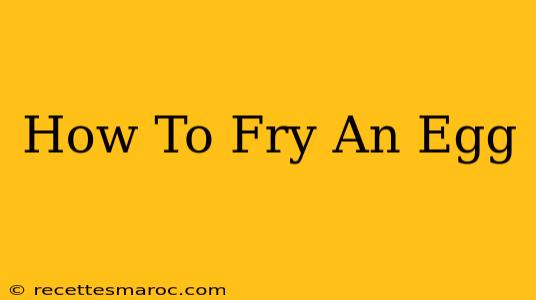Frying an egg might seem simple, but mastering the perfect fry – whether it's sunny-side up, over easy, or over hard – takes a little practice. This guide will walk you through the process, ensuring you achieve egg-cellent results every time! We'll cover everything from choosing the right pan to achieving that perfect yolk consistency.
Choosing Your Equipment and Ingredients
Before you even crack an egg, let's talk about the essentials:
1. The Right Pan:
A non-stick pan is your best friend when frying eggs. It prevents sticking and makes cleanup a breeze. Choose a pan that's appropriately sized for the number of eggs you're cooking – overcrowding the pan will lead to uneven cooking. A medium-sized pan (8-10 inches) is perfect for 2-3 eggs.
2. The Perfect Egg:
Freshness matters! While you can fry older eggs, fresher eggs hold their shape better and have brighter, more vibrant yolks.
3. Fat of Choice:
Butter, oil, or a combination of both work well. Butter adds flavor, while oil provides a higher smoke point, preventing burning. Use about a tablespoon of fat for a medium-sized pan.
4. Salt and Pepper:
These are your flavor enhancers. Season your eggs to taste after cooking or sprinkle a pinch of salt on top before frying for a crispier white.
Frying Techniques: Mastering the Different Styles
Let's dive into the different ways to fry an egg, each with its own unique charm:
1. Sunny-Side Up:
This classic method leaves the yolk completely runny.
-
Instructions: Heat your pan over medium-low heat. Add your fat and let it melt. Crack your eggs gently into the pan. Cook for 3-4 minutes, or until the whites are set but the yolk remains runny. Avoid high heat, which will cook the yolk too quickly.
-
Tips: For extra crispy whites, gently spoon some of the hot melted butter/oil over the whites during cooking.
2. Over Easy:
Similar to sunny-side up, but with a quick flip to cook the top of the yolk slightly.
-
Instructions: Follow the steps for sunny-side up. Once the whites are set, gently flip the egg using a spatula. Cook for another 15-30 seconds, just until the top of the yolk is slightly cooked.
-
Tips: Use a thin spatula to prevent breaking the yolk when flipping.
3. Over Medium:
The yolk is cooked more than over easy, but still slightly runny.
- Instructions: Follow the steps for sunny-side up. Flip the egg and cook for about 45-60 seconds, or until the yolk is partially set but still slightly runny.
4. Over Hard:
The yolk is fully cooked.
- Instructions: Follow the steps for sunny-side up. Flip the egg and cook for 1-2 minutes, or until the yolk is fully cooked and firm.
Troubleshooting Common Problems:
- Sticking: Use a non-stick pan and ensure your pan is properly heated. Don't overcrowd the pan.
- Burnt Edges: Reduce the heat.
- Unevenly Cooked Whites: Maintain a consistent low-to-medium heat.
Serving Suggestions:
Your perfectly fried egg is incredibly versatile. Serve it on toast, in a sandwich, as part of a breakfast burrito, or atop a salad. The possibilities are endless!
Conclusion:
Mastering the art of frying an egg is a rewarding culinary skill. With a little practice and attention to detail, you'll be creating perfect eggs every time. So, crack those eggs and enjoy the deliciousness! Remember to share your perfectly fried egg creations – we'd love to see them!

